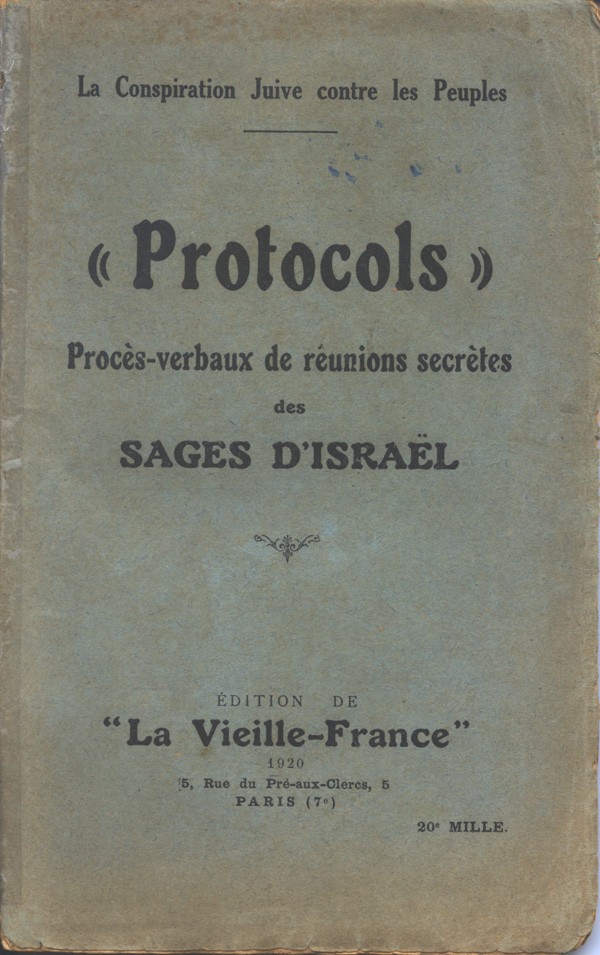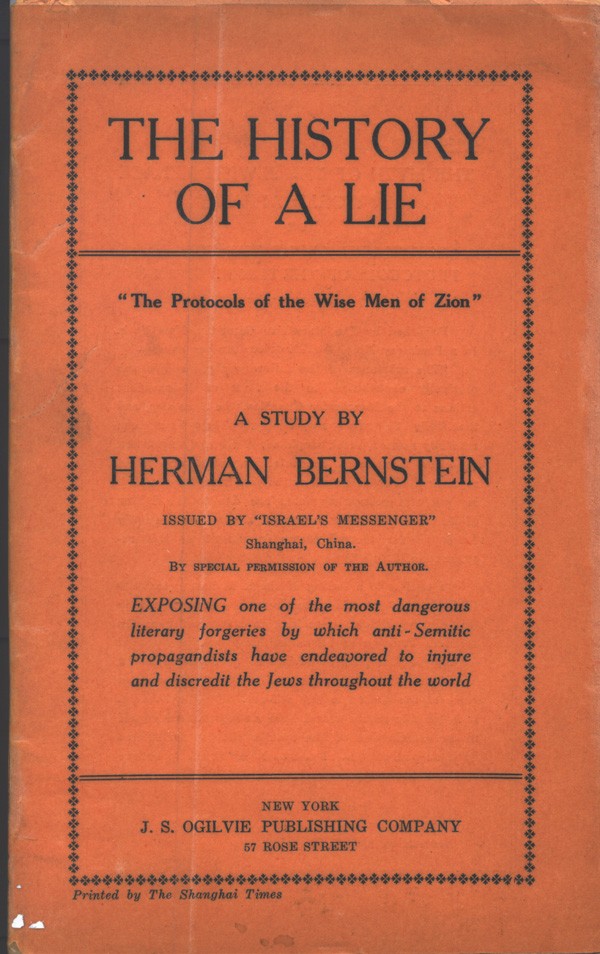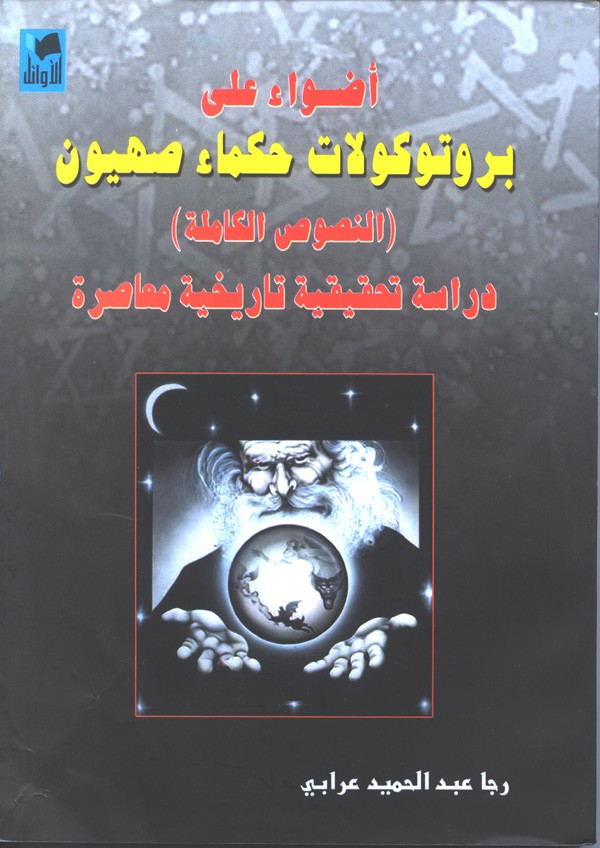
Protocols of the Elders of Zion: Key Dates
The Protocols of the Elders of Zion is the most widespread antisemitic publication of modern times. Below is a list of selected dates related to its publication and distribution.
The Protocols of the Elders of Zion is the most widespread antisemitic publication of modern times. It is based on false conspiracy theories about Jews plotting to take over the world.
The Protocols claims to be a secret, written record of meetings supposedly held by a group called the “learned elders of Zion.” The meeting notes are fake. These meetings never took place and the purported leaders, the so-called Elders of Zion, never existed.
The Protocols was first published in the Russian Empire in 1903. Since the 1920s, the Protocols has been exposed as a lie by journalists, courts, and governments worldwide. Nevertheless, it continues to be published in multiple languages and countries, including the United States. Today, the Protocols circulates in print, on television, on the Internet, and on social media.
The selected dates below show how this powerful piece of antisemitic propaganda has spread over time.
April 1903
During a pogrom in Kishinev, perpetrators of deadly violence against Jews repeatedly invoke the name of Pavel Krushevan. Krushevan was an accomplished writer and ruthless antisemite. Later in 1903, a newspaper owned by Krushevan publishes the first version of The Protocols of the Elders of Zion.
Autumn 1903
A serialized version of the Protocols is published for the first time in St. Petersburg, Russia. It is published on the pages of a newspaper called Znamya (The Banner).
1905
Russian mystic and prolific writer Sergei Nilus includes the Protocols as an appendix to his book, The Great in the Small: The Coming of the Anti-Christ and the Rule of Satan on Earth. Nilus presents Jews as agents of satanic forces seeking to destroy the world.
1917
The Russian tsar abdicates the throne in the midst of a popular revolution in March. The Russian Provisional Government is established. That autumn, the Bolshevik Party (later, the Communist Party) seizes power from the Provisional Government. Some opponents of the revolution echo ideas from the Protocols. They blame Jews for bringing Communism to Russia.
1918–1921
During the Russian Civil War, anti-Communist armies publish the Protocols and other antisemitic propaganda. Pogroms carried out against Jews, primarily in Ukraine, result in the deaths of tens of thousands.
1919
Anti-Communist émigrés who flee to Europe after the Russian Revolution take the Protocols with them.
The first non-Russian language edition of the Protocols is published in Germany. A decade later in 1929, the Nazi Party secures the copyright to this edition. By 1938, the Nazi Party’s publishing house will issue 22 printings of the Protocols.
1920
The Protocols is published in France, England, the United States, and Japan. These editions blame the 1917 Russian Revolution on Jewish conspirators. They also warn of Communism or Bolshevism spreading to the West.
1920
Lucien Wolf, a British journalist and diplomat, publishes The Jewish Bogey and the Forged Protocols of the Learned Elders of Zion. In this book, Wolf exposes the Protocols as a lie. He provides evidence that a German novel, Biarritz (1868), contains ideas that were used to fabricate the Protocols.
1920
Automaker Henry Ford’s newspaper, The Dearborn Independent, publishes a 91-part series of articles based on the Protocols. A book version titled The International Jew is translated into at least 16 languages.
August 1921
The Times (London) reveals that the Protocols is copied in large part from a French political satire: Maurice Joly's Dialogue in Hell Between Machiavelli and Montesquieu (1864). There is no mention of Jews in Dialogue in Hell. The Times declares the Protocols a “fake” and a “clumsy forgery.”
1921

The Protocols is published in Italy, Sweden, and Norway.
New York Herald reporter Herman Bernstein publishes The History of a Lie: The Protocols of the Wise Men of Zion. This is the first time that the Protocols is exposed as a fraud for an American audience.
1923
Leading Nazi thinker Alfred Rosenberg writes The Protocols of the Elders of Zion and Jewish World Policy. Rosenberg’s efforts make some Nazi Party leaders, including Adolf Hitler, aware of the Protocols.
1923
The Protocols is published in Poland.
1924
Benjamin Segel, a Jewish journalist in Germany, writes Die Protokolle der Weisen von Zion, kritisch beleuchtet (The Protocols of the Elders of Zion, Critically Illuminated). Segel’s book further exposes the Protocols as a forgery.
1924
Joseph Goebbels references the Protocols in his diary. He writes:
“I believe that The Protocols of the Wise Men of Zion are a forgery. . . . [However,] I believe in the intrinsic but not the factual truth of the Protocols.”
Goebbels will become the Nazi Minister of Public Enlightenment and Propaganda in 1933.
1925
Adolf Hitler publishes his autobiography, Mein Kampf. In it, he writes about the Protocols to reinforce his antisemitic claims and conspiracy theories.
1925
The Protocols is published in Damascus, Syria, a center of culture and nationalism in the Middle East. This first Arabic translation of the Protocols circulates widely.
1927
Henry Ford issues a public apology for publishing The International Jew. Ford directs that remaining copies be withdrawn from circulation. He also tells overseas publishers to stop publishing the book. However, they ignore him.
1929
The Nazi Party secures the copyright to the 1919 German-language edition of the Protocols.
1933
Adolf Hitler is appointed chancellor of Germany, paving the way for a Nazi dictatorship. Nazi propaganda plays an integral role in spreading the Nazi Party’s antisemitic message. It also helps advance the persecution—and later the killing—of Europe’s Jews. Julius Streicher, publisher of the Nazi Party’s antisemitic newspaper Der Stürmer, begins running lead stories that promote the Protocols.
1934
The South African Gentile National Socialist Movement (a Nazi group also known as the Greyshirts) are sued and fined for circulating a document that resembled the Protocols. A division of the South African Supreme Court rules that the Protocols is a lie.
1935
In 1935, a Swiss court rules against the Swiss National Front (a Nazi group) for distributing a German-language edition of the Protocols at a public demonstration. The trial judge refers to the Protocols as “ridiculous nonsense.” This decision is the outcome of a lawsuit filed in 1933 by two Jewish organizations in Berne, Switzerland.
1938
By 1938, the Nazi Party’s publishing house (Franz Eher Verlag) has issued 22 printings of the Protocols in Germany.
In the United States, Father Charles E. Coughlin serializes the Protocols in his newspaper, Social Justice. Coughlin was a Catholic priest in the metro Detroit area. Throughout the 1930s, he reached millions of listeners through his radio addresses.
1943
During World War II, the German authorities publish editions of the Protocols and other texts that promote lies about Jewish conspiracies in German-occupied France, Belgium, and Poland. They also publish the Protocols in Russian, Ukrainian, and Belarusian.
1943
In Arabic-language broadcasts airing on Berlin radio stations, the Mufti of Jerusalem Hajj Amin al-Husseini echoes themes of the Protocols. He claims that he has “secret Zionist documents” that confirm Jews’ supposed plans to destroy Islamic holy sites in British-controlled Mandatory Palestine.
1964
A US Senate Judiciary Subcommittee releases a report declaring that the Protocols are “a vicious hoax.” The report calls the Protocols “gibberish.” It also points out the fact that the book uses the same “big lie” propaganda technique used by Hitler.
1974
The Protocols is published in India under the title International Conspiracy Against Indians.
1985
An English-language edition of Protocols is issued in Iran. Its publisher is the Islamic Propagation Organization.
1988
The terrorist organization Hamas publishes its charter. Article 32 refers to the Protocols to justify calls for the annihilation of both Jewish people and the State of Israel.
1993
A Russian court rules that the Protocols is a forgery. The court also declares that publishing it is an antisemitic act.
2000
The Iranian government publishes an edition of the Protocols in Farsi.
2002
A privately owned Egyptian television channel broadcasts Horseman Without a Horse. It is a 41-part series based largely on the Protocols.
2002
The US Senate passes a resolution addressing use of the Protocols abroad. It urges the government of Egypt and other Arab states not to allow government-controlled television to broadcast any program that lends legitimacy to the Protocols.
2003
A 30-part television miniseries called Al Shatat (The Diaspora) airs on Hezbollah's Al-Manar TV. The series depicts a “global Jewish government,” as described in the Protocols.
2003
An exhibition of holy books at the Alexandria Library in Egypt includes a copy of the Protocols next to the Torah. The Torah is the most sacred Jewish text, which contains the first five books of the Bible. UNESCO publicly denounces the exhibition.
2004
Iran's Arabic-language Al-Alam TV airs a documentary series that draws on the Protocols. The series claims that Jews control Hollywood. It also denies that the Holocaust happened.
2004
A version of the Protocols is published in Okinawa, Japan.
2005

An edition of the Protocols is published in Mexico City. It suggests that the Holocaust was orchestrated by Jewish conspirators in exchange for the founding of the State of Israel.
2005
An edition of the Protocols authorized by the Syrian Ministry of Information is published. It claims that the Elders of Zion coordinated the September 11, 2001, terrorist attacks on the United States.
2012
Iranian President Mahmoud Ahmadinejad (in office from 2005 to 2013) draws on themes from the Protocols. He claims that Jews planned World War I and World War II. He also says that Jews control the US government.
2020
The Protocols is used to support the antisemitic lie that Jews are responsible for the COVID-19 pandemic.
2024
A report issued by the US Department of State explains that the Protocols retains significant influence in Russia, its land of origin. The report underscores that the Protocols are a fake, intended to promote hatred of Jews.
Critical Thinking Questions
How could the spread of a false story like the Protocols be a warning sign for genocide?
Why do lies and conspiracy theories often exist long after they are proven false?
How can individuals, groups, and governments combat the spread of and ill effects of misinformation?

